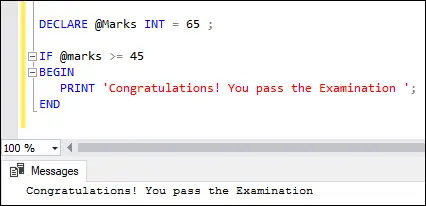IF-käsky on osa SQL Serverin ohjausvirtatoimintoa. Yleensä se on päätöksentekolausunto eri ohjelmointikielillä palauttaa arvon, joka perustuu annettuihin ehtoihin . Tämä lauseke suorittaa IF-lohkoon kirjoitetun koodin, kun annettu ehto on tosi ja kun ehto arvioi epätosi, suoritetaan ELSE-käsky.
IF:n lausunto
Seuraavassa on syntaksi, joka havainnollistaa tämän käskyn käyttöä SQL Serverissä:
IF boolean_expression BEGIN { statement_block } END Yllä olevassa syntaksissa lauseke_lohko in ALOITUS... LOPPU lohko suoritetaan, kun boolen_lauseke on tyytyväinen tilaan. Muussa tapauksessa tämä lohko ohitetaan ja ohjelman ohjaus siirretään käskyn jälkeen LOPPU avainsana. Meidän pitäisi tietää, että jos lauseke sisältää a VALITSE lausunto, meidän on tehtävä laita ne sulkeisiin .
Esimerkki
Katsotaanpa esimerkkiä IF-käskyn ymmärtämiseksi ilman ELSE-lohkoa. Alla oleva esimerkki näyttää tuloksen, kun ehto täyttyy. Muutoin ohjelman ohjaus siirtyi lauseeseen END-avainsanan jälkeen, jos sellainen on.
DECLARE @Marks INT = 65 ; IF @marks >= 45 BEGIN PRINT 'Congratulations! You pass the Examination'; END
Lausunnon suorittaminen antaa seuraavan tuloksen:

Nyt esittelemme sen alla olevalla Opiskelija' taulukko, jossa on seuraavat tiedot:

Alla on toinen esimerkki, joka saa pisteet yhteensä valitusta opiskelijasta ' Opiskelija' taulukko näytetietokannassa ja tulostaa sitten a viesti jos se on yli 400 .
BEGIN DECLARE @Total_Marks INT; SELECT @Total_Marks = total_marks FROM Student WHERE age>25; SELECT @Total_Marks; IF @Total_Marks > 400 BEGIN PRINT 'Congratulations! You pass the Examination'; END END
Saamme alla olevan tulosteen:

Jos haluamme nähdä yllä olevan tulostusviestin, meidän tulee napsauttaa Viestit välilehti:

IF-ELSE-lausunto
Tosimaailmassa meidän on suoritettava jokin toiminto aina, kun IF-lauseen ehto on TOSI tai EPÄTOSI. Tässä tapauksessa IF…ELSE-käsky on hyödyllinen. Tämä käsky suorittaa ELSE-käskylohkon, kun IF-lauseen ehto arvioidaan EPÄTOSI.
Seuraavassa on syntaksi, joka havainnollistaa IF ELSE -käskyn käyttöä SQL Serverissä :
IF expression BEGIN Statement block -- It executes when the IF clause expression is TRUE. END ELSE BEGIN Statement block -- It executes when the IF clause expression is FALSE. END
Esimerkki
Katsotaanpa esimerkkiä IF-käskyn ymmärtämiseksi ELSE-lohkolla. Alla oleva esimerkki näyttää viestin ' Onnittelut! Läpäiset kokeen ' kun IF-ehto täyttyy. Muussa tapauksessa näytä Olet epäonnistunut! Parempi onni ensi kerralla '.
DECLARE @Marks INT; SET @Marks = 65; IF @marks <45 begin print 'congratulations! you pass the examination'; end else 'you are failed! better luck next time'; < pre> <p>Executing the statement will give the below output. Here, the <strong>marks</strong> variable is <strong>65</strong> , and the <strong>condition (65<45)< strong> is not satisfied. Therefore, the message inside the ELSE block is displayed:</45)<></strong></p> <img src="//techcodeview.com/img/sql-server-tutorials/49/sql-server-if-else-5.webp" alt="SQL Server IF ELSE"> <p>We will get this output because the condition <strong>(65>45)</strong> is satisfied. Therefore, the message inside the IF block is displayed:</p> <img src="//techcodeview.com/img/sql-server-tutorials/49/sql-server-if-else-6.webp" alt="SQL Server IF ELSE"> <p>Now, we will demonstrate the IF ELSE statement on the above ' <strong>Student'</strong> table. In this example, we are going to check whether the student <strong>total marks</strong> is <strong>greater than or equal to 400</strong> or not as follows:</p> <ul> <li>When the IF condition is TRUE, we will get the student records whose total marks are greater than or equal to 550.</li> <li>If the condition is FALSE, we will get the student records whose total marks are less than 550.</li> </ul> <p>Here is the program:</p> <pre> DECLARE @Marks INT; SET @Marks = 600 ; IF @Marks >= 550 BEGIN SELECT id, name, gender, age, total_marks FROM Student WHERE total_marks >= 550 ORDER BY age ASC END ELSE BEGIN SELECT id, name, gender, age, total_marks FROM Student WHERE total_marks <550 order by age asc end < pre> <p>In this code, we have specified the <strong>@Marks</strong> variable to <strong>600</strong> , and the condition (600 >= 550) is satisfied. Therefore, we will get the output where student records whose total marks are greater than or equal to 550 are displayed.</p> <img src="//techcodeview.com/img/sql-server-tutorials/49/sql-server-if-else-7.webp" alt="SQL Server IF ELSE"> <p>If we changed the <strong>@Marks</strong> variable to <strong>500</strong> and the condition (500 >= 550) becomes false. Therefore, we will get the output where student records whose total marks are less than 550 are displayed.</p> <img src="//techcodeview.com/img/sql-server-tutorials/49/sql-server-if-else-8.webp" alt="SQL Server IF ELSE"> <h2>Nested IF ELSE Statement</h2> <p>Unlike other programming languages, we can nest an IF...ELSE statement inside another IF...ELSE statement in SQL Server. Let us demonstrate it with the following example:</p> <pre> DECLARE @age INT; SET @age = 6; IF @age <18 50 print 'you are underage'; else begin if @age < below 50'; senior cetizen'; end; pre> <p>In this example, we are going to check whether the <strong>age is underage, below 50, or senior citizen</strong> as follows:</p> <ul> <li>If the value of the <strong>@age</strong> variable is below <strong>18</strong> , it will print the person is <strong>underage</strong> .</li> <li>If the condition is FALSE, the ELSE part will be executed that has a nested IF…ELSE.</li> <li>If the value of the <strong>@age</strong> variable is under <strong>50</strong> , it will print <strong>below 50</strong> . Finally, if no condition is satisfied, it will print <strong>senior citizens</strong> .</li> </ul> <p>Here is the result:</p> <img src="//techcodeview.com/img/sql-server-tutorials/49/sql-server-if-else-9.webp" alt="SQL Server IF ELSE"> <p>This article gives a complete overview of how to use the SQL Server IF ELSE statement. Here we have learned:</p> <ul> <li>Variables are objects that serve as placeholders.</li> <li>The keyword BEGIN will be used to start a statement block, and the END keyword must be used to close it.</li> <li>The use of ELSE in an IF... ELSE statement is optional.</li> <li>It's also possible to nest an IF...ELSE statement inside another IF...ELSE statement. However, nesting an IF statement within another statement is bad practice because it makes the code difficult to read and maintain.</li> </ul> <hr></18></pre></550></pre></45>
